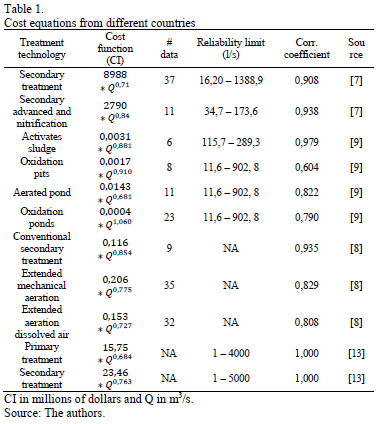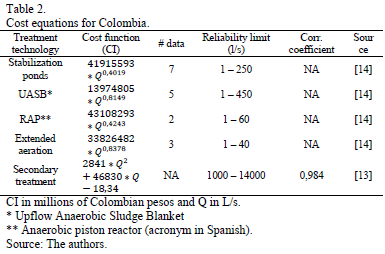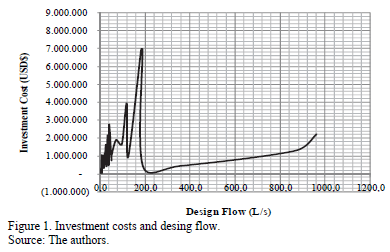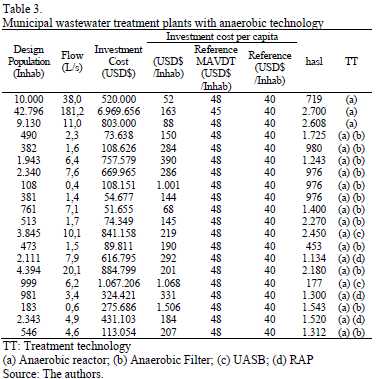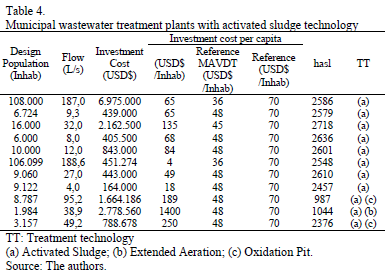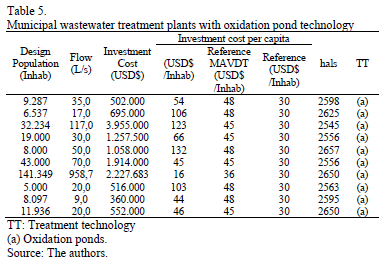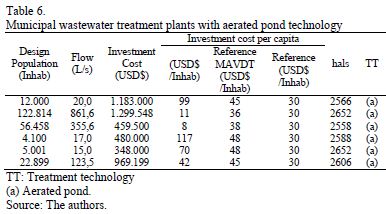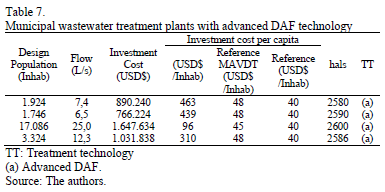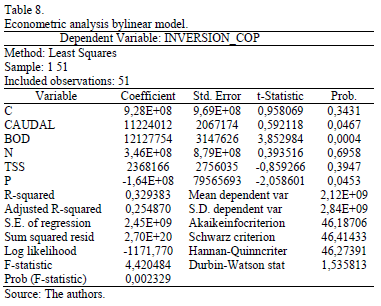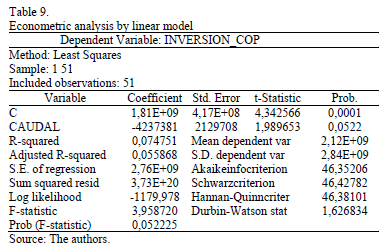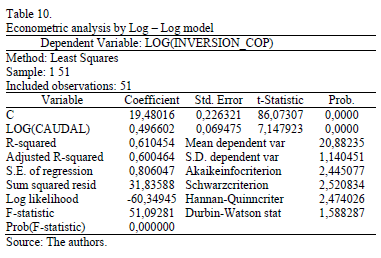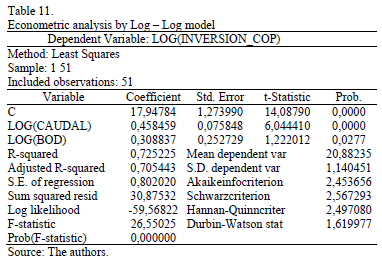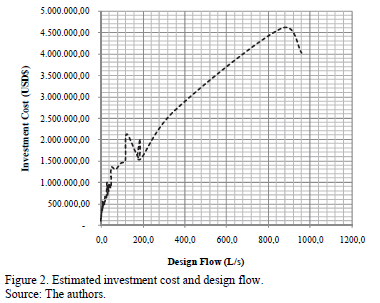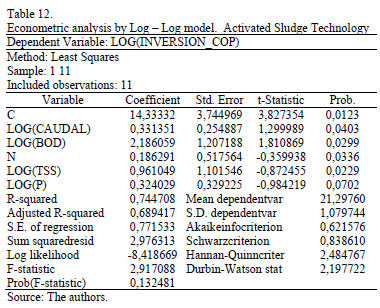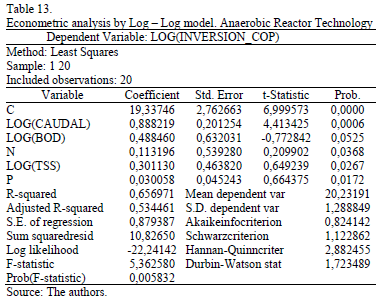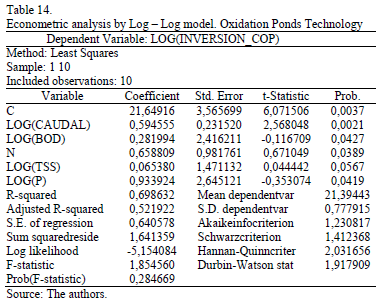Services on Demand
Journal
Article
Indicators
-
 Cited by SciELO
Cited by SciELO -
 Access statistics
Access statistics
Related links
-
 Cited by Google
Cited by Google -
 Similars in
SciELO
Similars in
SciELO -
 Similars in Google
Similars in Google
Share
DYNA
Print version ISSN 0012-7353
Dyna rev.fac.nac.minas vol.82 no.192 Medellín July/Aug. 2015
https://doi.org/10.15446/dyna.v82n192.44699
DOI: http://dx.doi.org/10.15446/dyna.v82n192.44699
Analysis of the investment costs in municipal wastewater treatment plants in Cundinamarca
Análisis de los costos de inversión en plantas de tratamiento de aguas residuales municipales en Cundinamarca
Juan Pablo Rodríguez-Miranda a, César Augusto García-Ubaque b & Juan Carlos Penagos-Londoño c.
a Faculty of the Environment. Universidad Distrital Francisco José de Caldas, Bogotá, Colombia. jprodriguezm@udistrital.edu.co.
b Faculty of Technology. Universidad Distrital Francisco José de Caldas, Bogotá, Colombia. cagarciau@udistrital.edu.co.
c Sub-General Management. Empresas Públicas de Cundinamarca S.A. E.S.P., Bogotá, Colombia. juan.penagos@epc.com.co.
Received: July 30th, 2014. Received in revised form: September 19th, 2014. Accepted: May 23th, 2015
This work is licensed under a Creative Commons Attribution-NonCommercial-NoDerivatives 4.0 International License.

Abstract
Some of the most significant aspects in the selection of wastewater treatment plants are the investment costs, since they cross-linkthe treatment level, the quality of the raw wastewater, the design flow and the purpose of the treated wastewater. Through a multivariable exponential regression analysis, data from 51 projects of new treatment plants was analyzed, and from that process, data of cost scale elasticity was obtained, in slow growth, in comparison to the design flow for each of the treatment technologies analyzed.
Key words. Wastewater treatment, investment, treatment capacity.
Resumen
Uno de los aspectos más importantes en la selección de plantas de tratamiento de aguas residuales son los costos de inversión debidos a los costos de interconexión, el nivel de tratamiento, la calidad de las aguas residuales crudas, el flujo de diseño y el destino final de las aguas residuales tratadas. A través de análisis multivariado de regresión exponencial, se analizaron datos de 51 proyectos de nuevas plantas de tratamiento. En este proceso, se obtuvieron datos de elasticidad de la escala de costos y se apreció un crecimiento lento en comparación con el flujo diseñado para cada una de las tecnologías de tratamiento analizadas.
Palabras clave. Tratamiento de aguas residuales, inversión, capacidad de tratamiento.
1. Introduction
The selection of municipal wastewater treatment plants (MWTP) has taken into consideration technical elements such as the concentrations of BOD5, TSS, N Total and P Total, without ignoring the population, eating habits, socioeconomic aspects, the municipal wastewater collection system and, of course, the flow and the direct costs of the MWTP project [1], to produce a high quality effluent in compliance with the regulations applicable to the discharge into the receptor body of water [2]. The above is taken into consideration when making technical decisions on wastewater management, for the purpose of decontaminating, but there is also the situation of procuring technical economic conditions, on the basis of an analysis, empirical in many cases, where the purpose is to interlink the construction costs, the treatment level and the design flow of the MWTPs [3,4].
Approximations have been made to the economic analysis of the MWTP relating the investment or construction cost and the design flow, establishing in a general manner a regression in function of the costs and flow of the MWTP, through an exponential equation [5-11]  where CI is the investment or construction cost, Q is the design flow, and a and b are calculated coefficients. However, constant a represents the cost of unit capacity and constant b is considered the constant of cost scale elasticity (always positive), where if b = 1, it means that the investment costs are directly proportional to the capacity or flow of the MWTP (costs increase linearly), if b< 1, it means that the costs advance less than proportionally to the capacity or size of the MWTP; that is, an economy of scale is present, which describes the behavior of costs according to the variable of flow or size [9], if while b is smaller in the cost function of the MWTP, it is considered that its cost grows more slowly as larger flows or capacities are considered for the MWTP; if b > 1 there would be a false economy of scale [10]; However, the literature reports values of the constant b between 0.68 - 0.954 [7].
where CI is the investment or construction cost, Q is the design flow, and a and b are calculated coefficients. However, constant a represents the cost of unit capacity and constant b is considered the constant of cost scale elasticity (always positive), where if b = 1, it means that the investment costs are directly proportional to the capacity or flow of the MWTP (costs increase linearly), if b< 1, it means that the costs advance less than proportionally to the capacity or size of the MWTP; that is, an economy of scale is present, which describes the behavior of costs according to the variable of flow or size [9], if while b is smaller in the cost function of the MWTP, it is considered that its cost grows more slowly as larger flows or capacities are considered for the MWTP; if b > 1 there would be a false economy of scale [10]; However, the literature reports values of the constant b between 0.68 - 0.954 [7].
The above has served to plan the new MWTPs, but only in the direct cost of construction or investment approximated to the level of pre-feasibility for the efficient assignment of resource [13]. The measurement of the impacts on the final users of a MWTP project indicates the order of priority of the investment and compares several MWTP projects without including aspects such as location, area, environmental impacts and local prices at the time of construction, among some other aspects. Some regressions of exponentials have been differentiated according to level or treatment process of the wastewaters as shown below in Table 1.
In Colombia several analyses of exponential regressions have been conducted [2,14-15], where costs functions have been formulated for different treatment systems, as shown in Table 2.
In the Interamerican Development Bank (BID for its acronym in Spanish) document [16], Development Objectives for the Millennium in Latin America, a universal goal was established, to reduce by half the percentage of people lacking access to drinking water and basic sanitation, something that requires great investments in each country. According to Corporación Andina de Fomento (CAF), the management study for the infrastructure in Latin America [17] established that homes in the region with access to water in their property was 87%, with access to a public sewer system 58%, and toilets connected to asewer system or septic system is 66%. In addition, the study further indicates that between 10% and 19.9% of the population in Colombia has an inadequate system for the elimination of excreta. The Pan American Health Organization's basic indicators report [18] for Latin America indicates that 80% of the population has access to an adequate supply of water, 54% of the population has access to an adequate sanitation system; in our country 92% of the total population has access to sources of potable water (99% in the urban area and 72% in the rural area) and 77% of the total population has access to sanitation installations (82% in the urban area and 63% in the rural area). Other indicators establish that coverage (urban and rural) of water supply is 91% and basic sanitation is 85% [19]. For the Department of Cundinamarca, aqueduct coverage is 81.26% and sewage system coverage is 66.08% [20]. However, an analysis of the sector, establishes that our country (water coverage 88%) in the 90s was above the average for Latin America and the Caribbean (average 85%). With regard to water coverage, in the years 2000 to 2010, it was found to be below average (average 93%) for Latin America and the Caribbean, but during the last few years, 2011 to 2013, it was placed above the average for Latin America and the Caribbean [21].
The National Plan for the management of municipal wastewaters in Colombia [22], indicates that 237 Wastewater Treatment Plans (WTP) have been constructedin the country (21.7% of all the municipalities in the country), generating 67 m3/s and, about 10% of those WTP present adequate operating conditions. However,for the rest of the WTP, the actual operating and working conditions are unknown; and it also establishes that the WTP do not treat the totality of the wastewater produced by the afferent municipalities. In 2010, an increase of 75.95 m3/s in the flow of wastewater was observed, but only 18.93 m3/s are treated, equivalent to 24.92% of the wastewaters generated from 454 WTP constructed [23].
The most widely used technologies in the WTP are aerobic and anaerobic ponds (55%), activated sludge (22%), percolator filters (14%), ascending flow anaerobic reactor (9%); however, the conditions of the WTP built (454), are as follows: 24% (108) in good conditions, 27% (122) in regular conditions, 22% (100) in deficient conditions and for 27% (124) the conditions are unknown [23]. The study [22] mentions that there should be an interrelation between the WTP, the sewage system and the receptor body, while taking into consideration concepts such as the integral management of the hydric resource, the pressure exerted over the resource, the preservation of the basins and the potential uses of the source, but does not establish the environmental assessment of the WTP with respect to the hydric basins. In addition, it can be mentioned that according to the World Bank the cost per capita for the treatment of wastewater is US$ 100 [20].
However, the technical report on wastewater treatment systems in Colombia-baseline 2010 [24]-establishes that out of the 1119 municipalities in Colombia, 490 have a WTP (43.80%) and out of these, a total of 556 WTP in Colombia, are located in the Departments of Cundinamarca and Antioquia. The installed capacity of WTP was 33.2 m3/s, and in conclusion, the report establishes: absence of monitoring and control of the processes; no characterization of the waters is made, there is no control of the inflow or the outflow, and the design flows are unknown so that the operation of the systems is conducted in an empirical, autonomous and routine manner. The lack of knowledge on the systems operated does not allow the careful planning of the expansion and optimization of the treatment systems, leads to the deterioration of the corrective and preventive maintenance plans for the wastewater treatment systems, and createsthe absence of programs for the control of vectors and the handling of sludge, making it difficult to monitor the discharge of non-residential wastewaters and compliance with the existing regulations.
In addition to the above, the analysis conducted by the Asociación Colombiana de Ingeniería Sanitaria y Ambiental (Colombian Association of Sanitary and Environmental Engineering) [25], indicates that 31% of the cities in Colombia have a WTP (primary treatment 29% and 1% tertiary treatment), where the following factors have been observed: incorrect selection of technologies, high investment and operating costs (although the investment assigned to the treatment of wastewaters does not reach the 1% invested or assigned to potable water), and very little protection of the hydric sources, jeopardizing environmental sustainability, due to the pollution of hydric resources, given the now obsolete premise used in Colombia, which states that the country's hydric resource is infinite.
Therefore, the cost function model for the MWTP in the Department of Cundinamarca developed in this research was obtained through the historic costs of the MWTPs already built and of the MWTP projects under construction with different flows or capacities and different water quality parameters (biochemical oxygen demand BOD, total suspended solids TSS, nitrogen N, phosphorous P) in different municipalities of the department. These serve as tools for the planning of the efficient use of the resources in preventing the pollution of the hydric basins based on the technology to be applied for the treatment of wastewater, the investment costs and its adaptability to the local environment.
2. Methodology
2.1. Type of Research
The type of research applied to the development of the cost function model of the MWTPs can be established from the prospective scope [26], given that the information is recorded as the phenomenon occurs, in this case, obtaining the information of future investment costs of the MWTP in the Department of Cundinamarca. However, according to the analysis and scope of the results, the research can also be quasi experimental [26] due to the fact that there is a causal relationship (cause - effect) between investment costs, wastewater flow and the physical parameters of the quality of raw wastewater that in conditions of rigorous control of the factors may affect the result of the analysis. Additionally, with the cost functions of the MWTPs, it willbe possible to foresee the efficient assignment of the investment resources for the preservation and conservation of the hydric basins in the department. For this reason, the research is also known as a forecast [27], given that future situations will be anticipated, under conditions of project horizon, demand of raw wastewater, compliance with current environmental regulations for the discharge of treated wastewater and institutional strengthening.
2.2. Data for the construction of the cost function
A Departmental Water Plan (DWP) has been implemented in Cundinamarca whereby prefeasibility studies have been conducted for the development of investments for the installation of MWTP in the different municipalities of this territorial entity, where the idea, profile and design of the different MWTP have been foreseen, for the purpose of strengthening the institutions, and conserving and managing the basins in the different provinces of the department through compliance with the current environmental regulations for the discharge of treated wastewater. In accordance with the above, to determine the cost functions for the MWTPs the data gathering and historic costs method was applied to 51 MWTP projects constructed or being constructed with different capacities or flows of wastewater (grouped according to the technologies for the treatment of wastewaters and taking the direct cost without Administration, Incidentals and Profit (AIUfor its acronym in Spanish) within the DWP and projects executed by the Autonomous Regional Corporation (CAR for its acronym in Spanish) in Cundinamarca, that is, future investment costs or costs of monitoring the construction of the MWTPs.
2.3. Data Analysis
The costs functions in the MWTP that express a exponential regression of the form  where CI is the investment or construction cost, Q is the design flow, BOD (biochemical oxygen demand), TSS (total suspended solids),N (nitrogen), P (phosphorous), a and b are calculated coefficients. This model allows the establishment of the relationships between variables and the identification of the existing dependency. In other words, a deterministic model that excludes external factors that produce fluctuations that influence the construction of the cost function, which means that it can be insufficient to explain the reality of the phenomenon. Consequently, the construction of a cost function of the MWTP should bestochastic or random, meaning that it includes unknown external information (represents the factors that affect the cost function of the MWTPs and that are not considered in the model) through error e, so that the model that better interprets reality can be better explained [28].
where CI is the investment or construction cost, Q is the design flow, BOD (biochemical oxygen demand), TSS (total suspended solids),N (nitrogen), P (phosphorous), a and b are calculated coefficients. This model allows the establishment of the relationships between variables and the identification of the existing dependency. In other words, a deterministic model that excludes external factors that produce fluctuations that influence the construction of the cost function, which means that it can be insufficient to explain the reality of the phenomenon. Consequently, the construction of a cost function of the MWTP should bestochastic or random, meaning that it includes unknown external information (represents the factors that affect the cost function of the MWTPs and that are not considered in the model) through error e, so that the model that better interprets reality can be better explained [28].
3. Results
Out of the 51 MWTP projects in the department of Cundinamarca, 39,2% of the MWTP have anaerobic reactor technologies (20 MWTP UASB, RAP reactors and anaerobic filters), 21,6% of the MWTPs have activated sludge technologies (11 MWTP extended aeration, oxidation pit and conventional reactors), 19,6% have oxidation pond technologies (10 MWTP), 11,8% have aerated ponds (6 MWTP) and 7,8% have advanced treatment technology with DAF (4 MWTP). The MWTP are distributed from 177 m.a.s.l up to 2718 m.a.s.l and with a flow rate of between 0.4 L/s and 958.7 L/s according to the quantity of inhabitants benefited. In terms of investment costs per MWTP, these range between USD$51655 and USD$6975000 and with a per capita cost of 4 USD$/inhab. to 1506 USD$/inhab.which indicates a considerable dispersion, since in countries such as Brazil (USD$40/inhab to USD$240/inhab), Peru (USD$90/inhab to USD$320/inhab), México (USD$10/inhab to USD$220/inhab), and even Colombia (USD$10/inhab to USD$289/inhab) present investment values per capita (secondary treatment) that are low in comparison to those reported in the MWTPs of Cundinamarca [14].
Fig. 1 shows the behavior of the investment costs according to the design flow or the treatment flow in the MWTP, where the tendency is to have a greater flow and thereby greater investment cost in the MWTP. In addition, it is observed that the largest concentration of projects is below 200 L/s. The average flow is 73.3 L/s and only 10 MWTP projects are above the aforementioned flow average and the remaining 41 MWTP projects are below it. The average investment cost is USD$1060046.9 and 13 MWTP projects are above the aforementioned average investment cost and the rest; that is, 38 projects are below the average investment cost. The average investment cost per capita is 229.18 USD$/inhab.
Table 3 shows that the 20 MWTP projects with anaerobic reactor technology, in terms of investment costs per capita all exceed the recommendation made by MAVDT {(for Colombia can be from USD$20/inhab to USD$40/inhab [29]}, of 48 USD$/inhabitant and the literature [30], of 40 USD$/ inhabitant. Even when the recommendation is to locate the MWTP with anaerobic technology below 1000 m.a.s.l.for the adequate stabilization of biogas [31], there are 13 MWTP projects above 1100 m.a.s.l., the flow range found goes from 0.4 L/s to 181.2 L/s.
Table 4, shows that out of the 11 MWTP projects with activated sludge technology, in terms of investment costs per capita, only two MWTP projects fulfill the recommendations from MAVDT (for Colombia, it can be from USD$40/inhab to a USD$120/inhab [29]) and six MWTP projects fulfill the recommendations of the literature [30]; Arceivala, 1981) of 70 USD$/inhab. The investment cost per capita for the activated sludge technology varies from 52 USD$/inhab to 1506 USD$/inhab, presenting a large dispersion of the data, since in countries like Brazil (USD$170/inhab to USD$270/inhab), Mexico (USD$50/inhab to USD$85/inhab), and even Colombia (USD$110/inhab to USD$175/inhab) present values for the investment per capita (secondary treatment) that are low in comparison with those reported for the MWTPs of Cundinamarca [14,32]. The flow range found goes from 4.0 L/s to 188.6 L/s. The vast majority of the MWTP projects are above 2000 m.a.s.l..
Table 5 shows that out of the 10 MWTP projects using oxidation pond technology, in terms of investment cost per capita only three MWTP projects fulfill the MAVDT recommendations (for Colombia, this can be from USD$10/inhab to USD$30/inhab [29]) and one MWTP project fulfills the recommendations made in the literature [30] of 30 USD$/inhabitant. The range of investment cost per capita found was USD$44/inhab to USD$132/inhab, which indicates a very high dispersion range, since it is estimated that the value of cost per capita in Colombia could be from USD$3.9/hab to USD$27.1/hab [32]. The flow range found went from 9.0 L/s to 958.7 L/s. It was also observed that all MWTP projects are located above 2500 m.a.s.l., even though the recommendation is to locate MWTPs with oxidation pond technologies below 1000 m.a.s.l.
Table 6 shows that out of the six MWTP projects with aerated pond technology, in terms of investment costs per capita, only three MWTP projects fulfill the MAVDT recommendations and two MWTP projects fulfill the recommendations made in the literature of 30 USD$/inhab [30]. The range of investment cost per capita went from USD$8/inhab to USD$117/inhab which is a considerable dispersion range since it is estimated that the value of the cost per capita in Colombia could be from USD$1.54/inhab to USD$3.87/inhab [31]. The range of the flow found went from 15.0 L/s to 861.6 L/s. It was also observed that all MWTP projects are located above 2500 m.a.s.l.
Table 7, shows that out of the four MWTP projects with advanced technology DAF, in terms of investment costs per capita, none of them fulfill the MAVDT recommendations (for Colombia it can be from USD$20/inhab to USD$30/inhab [29] or the literature [33] of 40 USD$/inhab. The range of the investment cost per capita found went from USD$96/inhab to USD$463/inhab, which is a high dispersion range since it is estimated that the value of the cost per capita in Colombia could be from USD$1.35/inhab to USD$3.87/inhab [32]. The range of the flow went from 6.5 L/s to 25 L/s. It was also observed that all MWTP projects are located above 2500 m.a.s.l.
Together with the information presented above, the econometric results of the model or cost function of the MWTP are presented for the 51 MWTP projects in the department of Cundinamarca.
3.1. First scenario
This scenario considers the value of the investment measured in Colombian pesos as a dependent variable, and the characteristics of the microbasins such as population, flow, BOD, TSS, N, and Pas independent variables. A linear model,and a log-log model are considered (Table 8).
The table above, shows that the model or cost function is as follows:  , which indicates that it is only analyzed for the significant variables within the model, that is, those whose probability value is less than 0.05; the investment cost of the MWTPs increases per each capacity (L/s), which means that the investment cost increases $11,224,012 COP as the flow increases for each L/s of capacity or flow and in turn the investment cost of the MWTP increases $12,127,754 COP per each mg/L in BOD concentration.
, which indicates that it is only analyzed for the significant variables within the model, that is, those whose probability value is less than 0.05; the investment cost of the MWTPs increases per each capacity (L/s), which means that the investment cost increases $11,224,012 COP as the flow increases for each L/s of capacity or flow and in turn the investment cost of the MWTP increases $12,127,754 COP per each mg/L in BOD concentration.
3.2. Second scenario
This scenario considers the value of the investment on the MWTP measured in Colombian pesos as a dependent variable and the flow as an independent variable.
Table 9 shows that the model or cost function as follows:  In this cost function of the MWTPs, the investment cost increases by COP$ 4,237,000 per each L/s of capacity or MWTPflow.
In this cost function of the MWTPs, the investment cost increases by COP$ 4,237,000 per each L/s of capacity or MWTPflow.
3.3. Third scenario
This scenario considers the model or cost function as a log-log, where the investment logarithm of the MWTP is estimated in Colombian pesos against the logarithm of flow or capacity of the MWTP. Comparing these two equations, it can be seen that the coefficient is a log estimator (investment cost), while the estimator of the flow is the exponent of the exponential function.
Table 10 shows that the model or cost function is as follows:  and the cost function is expressed as follows:
and the cost function is expressed as follows: ; The value of the coefficient expresses the elasticity of the flow in function of the cost which is 0.49, indicating that if the flow or capacity is increased by 1%, the cost of the investment in the MWTP will increase by 0.49% (less than the unit).
; The value of the coefficient expresses the elasticity of the flow in function of the cost which is 0.49, indicating that if the flow or capacity is increased by 1%, the cost of the investment in the MWTP will increase by 0.49% (less than the unit).
3.4. Fourth scenario
This scenario only contemplates logarithms in the dependent variable, in the flow and in the BOD, taking into account that for the other variables it is not significant.
Table 11 shows that the elasticity of the flow or capacity of the MWTP is 0.45 and BOD is 0.30, this is the model that adjusts the most (R adjusted 0.70) and the cost function is as follows: and expressed otherwise is:
and expressed otherwise is:  .
.
Fig. 2 shows the behavior of the investment costs function estimated according to the design flow or treatment flow of the MWTP. With regard to the investment costs function, it can be mentioned that in the model applied, 70% of the data adjusts to the model or the investment costs function of the MWTP according to the independent variables of flow (Q) or capacity of the MWTP and the BOD. The constant a (COP$61,836,230.21) is the cost of unit capacity and the constants b(cost scale elasticity) for Q (0.458459) and BOD (0.308837), meaning that the costs increase proportionally less than the capacity or flow of the MWTP.
3.5. Models per type of technology
The investment costs functions or models described below correspond to the estimates in accordance with the wastewater treatment technologies. The variables considered in the model are investment cost in the MWTP as the dependent variable and the flow or capacity, BOD, N, TSS and P as independent variables. The logarithm is only applied to those variables that do not contain zero or negative values.
Table 12 shows that the model or cost function for the activated sludge technology is as follows:  and the cost function is expressed as follows:
and the cost function is expressed as follows:  .
.
Table 13 shows that the model or cost function for the anaerobic reactor technology is as follows: and the cost function is expressed as:
and the cost function is expressed as:  .
.
Table 14 shows that the model or cost function for the oxidation ponds technology is as follows:  and the cost function is expressed as:
and the cost function is expressed as: .
.
For the aerated pond and advanced DAF technologies, the first model or the cost function is not significant because the sample is not representative. For the second, it is not possible to estimate the model or cost function because of the number of observations: four.
4. Conclusions
In terms of investment cost per capita for the MWTPs, there is evidence of a great dispersion of the data obtained. This is due to the fluctuation of the materials, equipment, and the civil works at the time of estimating the budget, which ostensibly affects the value calculated (investment cost per capita) in comparison with international and Latin American literature. For the most part, the investment costs are assumed indirectly by the inhabitants of the populations benefited, through the financing by the national government, and afterwards these costs are assumed directly through the charges for the operation and maintenance of the MWTP.
The investment cost functions of the MWTPs formulated are an appropriate tool for the selection of the decontamination model applied and in addition serves as an economic indicator for decision making and even for the evaluation of several alternatives of treatment. This is due to the fact that the investment cost of a MWTP is not proportional to the design flow, but rather mainly depends on the characteristics of the raw wastewater to be treated and consequently, the greater the quantity of contaminants eliminated from the wastewater, the greater the environmental damaged prevented, and therefore,the greater the benefit from the wastewater treatment process, because the entire treatment train of the MWTP is utilized.
Having cost functions to estimate long term economies of scale in the MWTPs in the department of Cundinamarca is specific to the capacity or flow of the MWTP considered in the analysis. Consequently, the elasticity of the cost scale (Q (0,458459) and BOD (0,308837)) meant that the investment costs rose slowly in comparison to the capacity or flow of the MWTP analyzed. Cost functions were obtained for the activated sludge, oxidation pond and anaerobic reactor technologies, while given the number of observations or data of MWTP projects with aerated pond or advanced DAF technologies, the cost function was not significant in the estimation of the model.
Acknowledgements
The authors wish to thank the Empresas Públicas de Cundinamarca S.A. E.S.P. of the Government of Cundinamarca, Colombia for the information provided on the MWTP investment projects within the Departmental Water Plan (PDA acronym in Spanish) as part of the agreement subscribed with the Universidad Distrital Francisco José de Caldas. Likewise, the authors express their gratitude to tenured professor Vidal Fernando Peñaranda Galvis from the Environmental and Natural Resources Faculty of the Universidad Distrital Francisco José de Caldas, for the review of the document.
References
[1] Molinos, M., Hernández, F. and Sala, R., Economic feasibility study for wastewater treatment: A cost - benefit analysis. Science of the environmental, 408 (20), pp. 4396-4402, 2010. [ Links ]
[2] Rodríguez, J.P., Selección técnico económico del sistema de depuración de aguas residuales: Aplicando la evaluación de la descontaminación hídrica. Tecnología del Agua, 306(29), 22-21, 2009. [ Links ]
[3] Posada, E., Mojica, D., Pino, N., Bustamante, C., y Monzon, A., Establecimiento de índices de calidad ambiental de ríos con bases en el comportamiento del oxígeno disuelto y de la temperatura: aplicación al caso del Río Medellín, en el Valle de Aburrá. Revista DYNA, 80 (181), pp 192-200, 2013. [ Links ]
[4] Restrepo, G., Rios, L., Marin, J., Montoya, J. y Velasquez, J., Evaluación del tratamiento fotocatalítico de aguas residuales industriales empleando energía solar. Revista DYNA, 75 (155), pp 145-153, 2008. [ Links ]
[5] United States Enviromental Protection Agency-USEPA, Construction cost for municipal wastewater treatment plants: 1973-1977. Washington: U.S. Environmental Protecion Agency. EPA/430/977014, 1978. [ Links ]
[6] United States Enviromental Protection Agency-USEPA, Construction cost for municipal wastewater treatment plants 1973-1978. Washington: U.S. Environmental Protecion Agency. EPA/430/980003, 1980. [ Links ]
[7] Friedler, E. and Pisanty, E., Effects of design flow and treatment level on construction and operation costs of municipal wastewater treatment plants and their implications on policy making. Water research, 40 (20), pp. 3751-3758, 2006. DOI: 10.1016/j.watres.2006.08.015 [ Links ]
[8] Tsagarakis, K.P., Mara, D.D., and Angelakis, A.N., Application of cost criteria for selection of municipal wastewater treatment systems. Water, air and soil pollution, 142 (1-4), pp. 187-210, 2003. DOI: 10.1023/A:1022032232487 [ Links ]
[9] Singhirunnusorn, W. and Stenstrom, M.K., A critical analysis of economic factors for diverse wastewater treatment process: Case studies in Thailand. Sustainble Environmental Research, 20 (4), pp. 263-268, 2010. [ Links ]
[10] Hernández-Sancho, F., Molinos-Senante, M. and Sala-Garrido, R., Cost modelling for wastwater treatment processes. Desalination, 268 (1), pp. 1-5, 2011. DOI: 10.1016/j.desal.2010.09.042 [ Links ]
[11] Revollo, D. and Londoño, G., Análisis de las economías de escala y alcance en los servicios de acueducto y alcantarillado en Colombia. Desarrollo y Sociedad, 66, pp. 145-182, 2010. [ Links ]
[12] Valenzuela, L.C., Evaluación económica y metodología de minimización de costos para proyectos de sistemas de agua potable. Desarrollo y Sociedad, [Online]. 19, pp. 147-171, 1987. Available at: http://www.academia.edu/11320913/Evaluaci%C3%B3n_Econ%C3%B3mica_y_Metodolog%C3%ADa_de_Minimizaci%C3%B3n_de_Costos_para_Proyectos_de_Sistemas_de_Agua_Potable [ Links ]
[13] Engin, G.O. and Demir, I., Cost analysis of alternative methods for wastewater handling in small communities. Journal of Environmental Management, 79 (4), pp. 357-363, 2006. DOI: 10.1016/j.jenvman.2005.07.011 [ Links ]
[14] Aristizábal, O.L., Referencias para costos de inversión en plantas de tratamiento de aguas residuales, en Pinilla J.I. Las ciudades y el agua: Ingenieros de EPM investigan sobre los sistemas hídricos urbanos. Medellin: Universidad de Medellin. 2011. pp. 337-348. [ Links ]
[15] Buitrago, C.A., and Giraldo, E., Evaluación técnica y económica de sistemas de tratamiento de aguas residuales. Bogotá: Universidad de los Andes. 1994. [ Links ]
[16] Banco Interamericano de Desarrollo - BID, Los objetivos de desarrollo del milenio en America Latina y el Caribe: Retos, acciones y compromisos. Washington D.C.: Banco Interamericano de Desarrollo. 2004. [ Links ]
[17] Corporación Andina de Fomento - CAF, Caminos para el futuro: Gestión de la infraestructura en América Latina. Caracas: Corporación Andina de Fomento, 2009. [ Links ]
[18] Organización Panamericana de la Salud - OPS, Indicadores básicos: Situacion de salud en la americas. Washington: Organización Panamericana de la Salud, 2012. [ Links ]
[19] Sánchez J., Estudio sectorial de los sistemas de acueducto y alcantarillado en Colombia, Memorias 56 Congreso Internacional: Agua, Saneamiento, Ambiente y Energía Renovable ACODAL Tomo I, [Online]. 2013. pp. 1-34. Available at: http://www.acodal.org.co/acodiario2012/imagenes/docweb56/Memorias%20Congreso%20Acodal/Presentaciones/Jaime%20S%e1nchez%20De%20Guzm%e1n%20-%20Superservicios.pdf [ Links ]
[20] Marín, C. and Serna, M., Análisis del costo per capita de ampliación de cobertura a nivel nacional de los servicios de acueducto y alcantarillado. Revista Regulación de Agua Potable y Saneamiento Básico, 16, pp. 153-190, 2011. [ Links ]
[21] Asociación Colombiana de Ingeniería Sanitaria y Ambiental - ACODAL, Agua potable y saneamiento: Colombia se rezaga en el contexto Latinoamericano. Bogotá: ACODAL. 2013 [ Links ]
[22] Ministerio de Ambiente, Vivienda y Desarrollo Territorial - MAVDT, Plan nacional de manejo de aguas residuales municipales en Colombia. Bogotá D.C.: MAVDT. 2004. [ Links ]
[23] Ministerio de Ambiente, Vivienda y Desarrollo Territorial - MAVDT, Politica nacional para la gestión integral del recurso hídrico. Bogotá D.C.: MAVDT. 2010. [ Links ]
[24] Superintendencia de Servicios Públicos Domiciliarios, Informe técnico sobre sistemas de tratamiento de aguas residuales en Colombia - línea base 2010. Bogotá D.C.: Superintendencia de Servicios Públicos Domiciliarios. 2012. [ Links ]
[25] Asociación Colombiana de Ingeniería Sanitaria y Ambiental - ACODAL, Aguas residuales y ciudades. Bogotá: Asociación Colombiana de Ingeniería Sanitaria y Ambiental. 2013. [ Links ]
[26] Vergel, G., Metodología. Un manual para la elaboración de diseños y proyectos de investigación. Compilación y ampliación temática. Barranquilla: Publicaciones Corporación UNICOSTA. 1997. [ Links ]
[27] Hurtado, J., Metodología de la investigación holística. Caracas: Fundación SYPAL. 2000. [ Links ]
[28] Gallego, J. and Pinilla, M., Modelo económetrico básico: Teoría y conceptos. Madrid: Académica Española. 2012. [ Links ]
[29] Salas, D., Zapata, M. and Guerrero J., Modelo de costos para el tratamiento de las aguas residuales en la región. Scientia et Technica, 13 (37), pp. 591-596, 2007. [ Links ]
[30] Von Sperling, M., Comparison among the most frequently used systems for wastewater treatment in developing countries. Water Science and Technology, 53 (3), pp. 59-62, 1996. DOI: 10.1016/0273-1223(96)00301-0 [ Links ]
[31] Ghazy, M.R., Dockhorn, T. and Dichtl, N., Economic and environmental assessment of sewage sludge treatment processes application in Egypt. International Water Technology Journal, 1 (2), pp. 1-17, 2011. [ Links ]
[32] Sarmiento, G., Documento de manejo de aguas residuales urbanas y tasas retributivas. Memorias Seminario internacional sobre tratamiento de aguas residuales y biosólidos. Fundación Universitaria de Boyacá, Tomo I. 2000. [ Links ]
[33] Fresenius, W. y Schneider, W., Manual de disposición de aguas residuales. Lima: Centro panamericano de ingeniería sanitaria y ciencias ambientales (CEPIS/OPS/OMS). 1991. [ Links ]
J.P. Rodriguez-Miranda, is Sanitary and Environmental Engineering, MSc. in Environmental Engineering. PhD (c) Engineering. He is associate professor of the Universidad Distrital Francisco José de Caldas, Bogotá, Colombia. Director of the research group AQUAFORMAT.
C.A. García-Ubaque, is Civil Engineer, PhD in Engineering He is associate professor of the Universidad Distrital Francisco José de Caldas, Bogotá, Colombia. Head of research group GIICUD.
J. C. Penagos-Londoño, is Civil Engineer, MSc. in Civil Engineering. Deputy General Manager. Cundinamarca PublicEnterprises Inc. E.S.P.













